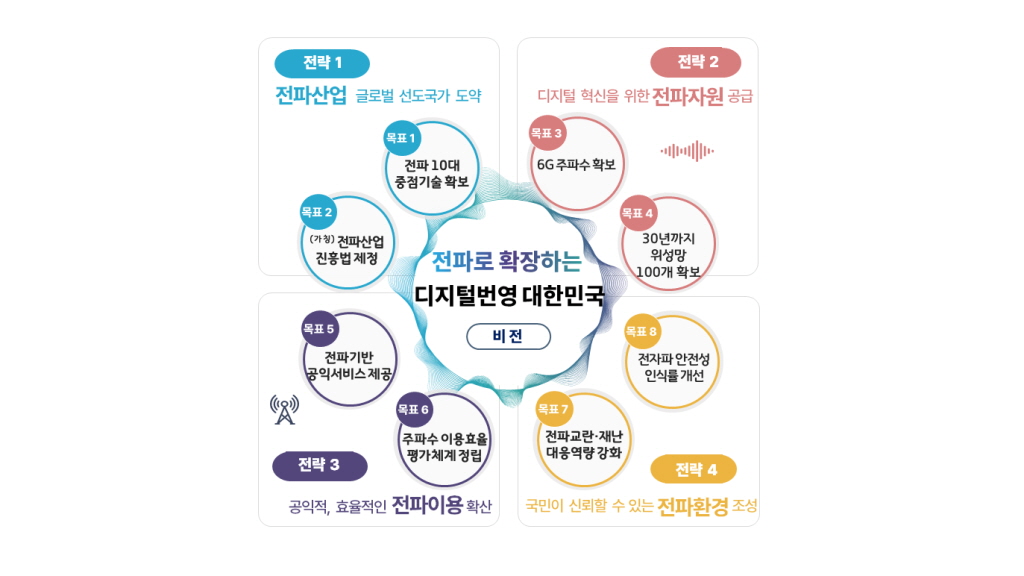정부가 5년마다 마련되는 전파진흥기본계획을 새롭게 발표하며 전파의 공간적, 물리적, 기능적 한계를 극복하고, 전파의 공익적 활용 및 글로벌 무선시장 선점을 위한 역량 확충에 본격 나선다.

▲제4차 전파진흥기본계획의 비전 및 목표
제4차 전파진흥기본계획 발표, 5대 분야·10대 중점기술 선정·육성
공간적·물리적·기능적 한계 극복, 글로벌 무선시장 선점 역량 확충
정부가 5년마다 마련되는 전파진흥기본계획을 새롭게 발표하며 전파의 공간적, 물리적, 기능적 한계를 극복하고, 전파의 공익적 활용 및 글로벌 무선시장 선점을 위한 역량 확충에 본격 나선다.
과학기술정보통신부(장관 유상임)는 16일 경제관계장관회의를 통해 ‘제4차 전파진흥기본계획’을 발표했다.
‘전파진흥기본계획’은 전파법을 근거로 하는 법정계획으로서 2023년 5월부터 산·학·연 전문가 등이 60여 차례의 회의를 거쳐 다양한 과제를 발굴했으며, 전파정책자문회의, 기업·연구·학계 등 외부검토(3회), 공청회, 과학기술 유관단체 대상 메일링 등을 통해 다양한 의견을 청취했다.
이번에 발표하는 ‘제4차 전파진흥기본계획’은 전파의 확장과 활용을 극대화하여 디지털 혁신 선도국가를 실현하기 위한 중장기 전략으로서 ‘전파로 확장하는 디지털 번영 대한민국’이라는 비전하에 4대 전략과 주요 목표를 제시했다.
전략1은 ‘전파산업의 글로벌 선도국가 도약’으로 △전파 10대 중점기술 확보 △전파산업진흥법(가칭) 제정을 주요 목표로 한다.
전략2는 ‘디지털 혁신을 위한 전파자원 공급’으로 △6G 주파수 확보 △2030년까지 위성망 100개 확보를 주요 목표로 한다.
전략3은 ‘공익적, 효율적인 전파이용 확산’으로 △전파기반 공익서비스 제공 △주파수 이용효율 평가체계 정립을 주요 목표로 한다.
전략4는 ‘국민이 신뢰할 수 있는 전파환경 조성’으로 △전파교란·재난 대응역량 강화 △전자파 안전성 인식률 개선을 주요 목표로 한다.
이를 위해 전략 1에서는 무선 디지털 확장을 견인하는 전파한계극복을 위해 5대 전략분야, 10대 중점기술을 선정, 육성한다.
5대 전략분야는 △위성통신 △비지상통신 △극한전파 △전파에너지 △전파융합이 선정됐고, 10대 중점기술로는 △차세대 위성통신 △초소형 IoT 위성 △공중통신 △지중·수중통신 △매질한계 극복통신 △극고주파 통신·센싱 △무선전력전송 △전파전력저감 △이음5G △전파헬스케어 등이 선정됐다.
이와 함께 글로벌 무선 시장 선점을 위한 전파 핵심 역량 확충에 나서고, 글로벌 전파기업 육성을 위햇 K-스펙트럼펀드 신설을 검토한다.
또한 전파산업 진흥을 위한 법·제도 정립에도 나선다.
여기에 초고속·대용량 무선 인프라용 주파수 확보·공급 및 미래 무선 산업·서비스를 선도하는 선제적 주파수 공급에도 나선다.
더불어 전파를 활용한 국민공감 디지털 시대실현을 위해 전파의 공익적 활용확산에도 나서고, 효율적이고, 공정한 전파이용 환경을 조성한다.
또한 전파 혼간섭 예방·대응을 통한 강건한 전파안보 확립 및 합리적 제도 및 엄정한 관리로 깨끗한 전파환경 조성에도 나선다.
더불어 재해로부터의 국민안전 및 재산보호를 위해 홍수·산불 통합공공망 등 인명구조·재난관련 무선국에 대한 안전점검의 법적근거 및 점검기준을 마련할 예정이다.
과기정통부 유상임 장관은 “전세계적인 디지털 혁신 흐름 속에서 대부분의 디지털 서비스들이 무선화됨에 따라, 데이터의 원활한 흐름을 뒷받침하는 전파의 중요성이 점차 커지고 있다”며 “디지털 혁신의 핵심자원인 전파기술 개발과 전파산업의 성장을 적극 지원하고, 국민들이 안심하고 전파를 활용할 수 있는 환경을 조성해 나가겠다”고 밝혔다.
 ▲제4차 전파진흥기본계획의 비전 및 목표
▲제4차 전파진흥기본계획의 비전 및 목표